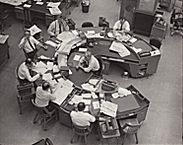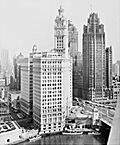| Entries |
| C |
|
Chicago Tribune
|

|

|
After an eight-year period in which the paper was dominated by liberal maverick editor Horace White, Medill regained control in 1874. Driven in part by competition from the Chicago Daily News and other papers, the Tribune gradually introduced more illustrations and reduced its price from five cents per copy to a penny. In 1901, two years after Medill's death, it installed its first color press.
In the following decade, the Tribune was led by Medill's son-in-law Robert Patterson and editor James Keeley. Presenting itself as a champion of reform, the paper set its sights on political corruption. The targets of its investigations and editorials included not only Democrats but also Republican machine politicians such as U.S. Senator William Lorimer, whom the Tribune forced out of Congress.
Between the 1910s and the 1950s, the Tribune prospered under the leadership of Medill's grandson Robert R. McCormick. Calling his operation the “World's Greatest Newspaper,” McCormick succeeded in raising daily circulation from 230,000 in 1912 to 650,000 by 1925, when the Tribune stood as the city's most widely read paper. In 1925, when it moved into the Tribune Tower on North Michigan Avenue, the paper employed about two thousand men and women. During the 1930s and 1940s, McCormick used the Tribune's editorial pages to attack the New Deal and promote isolationism and anti-Communism.
After McCormick died in 1955, the Tribune moved toward a more moderate (if still Republican) editorial stance, as it increasingly became the product less of individual personalities than of a large business corporation. Meanwhile, the Tribune's younger media cousins were growing faster than the newspaper itself. This development had begun under McCormick, who oversaw the founding of WGN (after “World's Greatest Newspaper”) radio in 1924 and WGN television in 1948. By the end of the twentieth century, when the newspaper's parent company (the Tribune Company) was a national media giant that employed close to six thousand Chicago-area residents, the future of traditional print dailies was uncertain. Nevertheless, the Tribune, now available in electronic form, continued to be Chicago's leading newspaper.
The Encyclopedia of Chicago © 2004 The Newberry Library. All Rights Reserved. Portions are copyrighted by other institutions and individuals. Additional information on copyright and permissions.